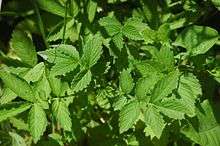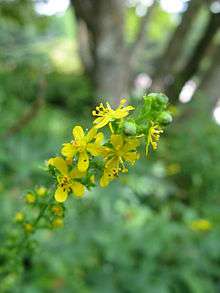Agrimonia pilosa
| Agrimonia pilosa | |
|---|---|
 | |
| Scientific classification | |
| Kingdom: | Plantae |
| (unranked): | Angiosperms |
| (unranked): | Eudicots |
| (unranked): | Rosids |
| Order: | Rosales |
| Family: | Rosaceae |
| Genus: | Agrimonia |
| Species: | A. pilosa |
| Binomial name | |
| Agrimonia pilosa Ledeb.[1] | |
Agrimonia pilosa (Hangul: 짚신나물), also known as hairy agrimony, is a flowering plant in the Rosaceae family. It is distributed primarily over the Korean Peninsula, Japan, China, Siberia, and Eastern Europe.[2]
Ecology

Agrimonia pilosa is a perennial herb with erect stem growing 30–120 cm (12–47 in) in height.[3] It grows along roadsides or in grassy areas at divers altitudes.[2] It can grow in light sandy, loamy, or heavy soils. Its suitable pH for growing properly is acid or basic alkaline soils.
It has many lateral roots and its rhizome is short and usually tuberous.[3] Its stems are colored yellowish green or green and its upper part is sparsely pubescent and pilose, but the lower part had dense hairs. Its leaves are green, alternate and odd-pinnate with two to four pairs of leaflets. The number of leaflets reduces to three on upper leaves. The leaves are oval and edged with pointy teeth of similar size. The leaves are 3–6 cm (1.2–2.4 in) long and 1.5–3.5 cm (0.59–1.38 in) wide.[2] And it is hairy on both sides.
Chemical constituents
Agrimonia pilosa contains certain chemical components such as agrimonolide, coumarin, tannins, as well as flavonoids, phenylpropanoids, and triterpenes.[2]
Traditional medicine
Agrimonia pilosa is traditionally used in Korea for boils, eczema, and taeniasis (a tape worm condition).[2] In Nepal and China, A. pilosa is traditionally used for abdominal pain, sore throat, headaches, and heat stroke.[2]
References
- ↑ Agrimonia pilosa was originally described and published in Index sem. hort. Dorpat., suppl. 1. 1823. GRIN (10 March 2003). "Agrimonia pilosa information from NPGS/GRIN". Taxonomy for Plants. National Germplasm Resources Laboratory, Beltsville, Maryland: USDA, ARS, National Genetic Resources Program. Retrieved 28 October 2013.
- 1 2 3 4 5 6 Medicinal plants in the republic of Korea. Natural Products Research Institute Seoul National University. 1998. p. 15. ISBN 92 9061 120 0.
- 1 2 Flora of China, FOC vol.9. "Agrimonia pilosa". Retrieved 28 October 2013.